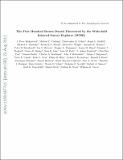The First Hundred Brown Dwarfs Discovered by the Wide-field Infrared Survey Explorer (WISE)
Author(s)
Bochanski, John J.; Simcoe, Robert A.
DownloadSimcoe_The first.pdf (4.237Mb)
OPEN_ACCESS_POLICY
Open Access Policy
Creative Commons Attribution-Noncommercial-Share Alike
Terms of use
Metadata
Show full item recordAbstract
We present ground-based spectroscopic verification of 6 Y dwarfs (see also Cushing et al.), 89 T dwarfs, 8 L dwarfs, and 1 M dwarf identified by the Wide-field Infrared Survey Explorer (WISE). Eighty of these are cold brown dwarfs with spectral types ≥T6, six of which have been announced earlier by Mainzer et al. and Burgasser et al. We present color-color and color-type diagrams showing the locus of M, L, T, and Y dwarfs in WISE color space. Near-infrared and, in a few cases, optical spectra are presented for these discoveries. Near-infrared classifications as late as early Y are presented and objects with peculiar spectra are discussed. Using these new discoveries, we are also able to extend the optical T dwarf classification scheme from T8 to T9. After deriving an absolute WISE 4.6 μm (W2) magnitude versus spectral type relation, we estimate spectrophotometric distances to our discoveries. We also use available astrometric measurements to provide preliminary trigonometric parallaxes to four of our discoveries, which have types of L9 pec (red), T8, T9, and Y0; all of these lie within 10 pc of the Sun. The Y0 dwarf, WISE 1541–2250, is the closest at 2.8[superscript +1.3] [subscript –0.6] pc; if this 2.8 pc value persists after continued monitoring, WISE 1541–2250 will become the seventh closest stellar system to the Sun. Another 10 objects, with types between T6 and >Y0, have spectrophotometric distance estimates also placing them within 10 pc. The closest of these, the T6 dwarf WISE 1506+7027, is believed to fall at a distance of ~4.9 pc. WISE multi-epoch positions supplemented with positional info primarily from the Spitzer/Infrared Array Camera allow us to calculate proper motions and tangential velocities for roughly one-half of the new discoveries. This work represents the first step by WISE to complete a full-sky, volume-limited census of late-T and Y dwarfs. Using early results from this census, we present preliminary, lower limits to the space density of these objects and discuss constraints on both the functional form of the mass function and the low-mass limit of star formation.
Date issued
2011-11Department
Massachusetts Institute of Technology. Department of PhysicsJournal
Astrophysical Journal
Publisher
IOP Publishing
Citation
Davy Kirkpatrick, J. et al. “The First Hundred Brown Dwarfs Discovered by the Wide-field Infrared Survey Explorer (WISE).” The Astrophysical Journal Supplement Series 197.2 (2011): 19.
Version: Author's final manuscript
ISSN
0004-637X
1538-4357